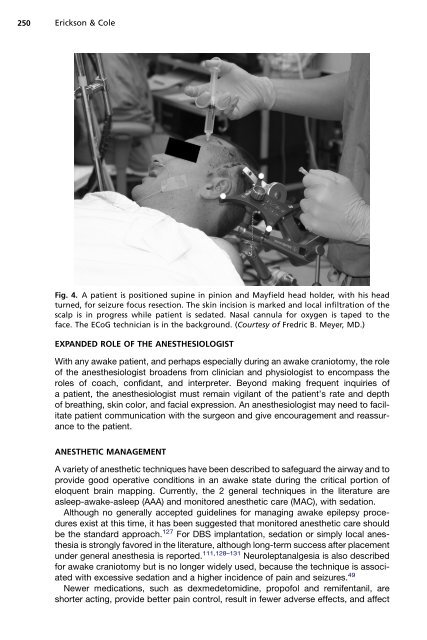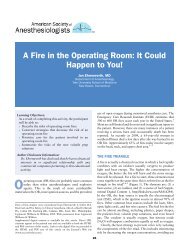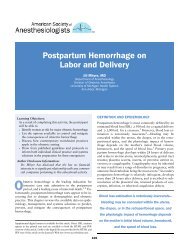Anesthetic Considerations for Awake Craniotomy for Epilepsy ... - Vtr
Anesthetic Considerations for Awake Craniotomy for Epilepsy ... - Vtr
Anesthetic Considerations for Awake Craniotomy for Epilepsy ... - Vtr
You also want an ePaper? Increase the reach of your titles
YUMPU automatically turns print PDFs into web optimized ePapers that Google loves.
250<br />
Erickson & Cole<br />
Fig. 4. A patient is positioned supine in pinion and Mayfield head holder, with his head<br />
turned, <strong>for</strong> seizure focus resection. The skin incision is marked and local infiltration of the<br />
scalp is in progress while patient is sedated. Nasal cannula <strong>for</strong> oxygen is taped to the<br />
face. The ECoG technician is in the background. (Courtesy of Fredric B. Meyer, MD.)<br />
EXPANDED ROLE OF THE ANESTHESIOLOGIST<br />
With any awake patient, and perhaps especially during an awake craniotomy, the role<br />
of the anesthesiologist broadens from clinician and physiologist to encompass the<br />
roles of coach, confidant, and interpreter. Beyond making frequent inquiries of<br />
a patient, the anesthesiologist must remain vigilant of the patient’s rate and depth<br />
of breathing, skin color, and facial expression. An anesthesiologist may need to facilitate<br />
patient communication with the surgeon and give encouragement and reassurance<br />
to the patient.<br />
ANESTHETIC MANAGEMENT<br />
A variety of anesthetic techniques have been described to safeguard the airway and to<br />
provide good operative conditions in an awake state during the critical portion of<br />
eloquent brain mapping. Currently, the 2 general techniques in the literature are<br />
asleep-awake-asleep (AAA) and monitored anesthetic care (MAC), with sedation.<br />
Although no generally accepted guidelines <strong>for</strong> managing awake epilepsy procedures<br />
exist at this time, it has been suggested that monitored anesthetic care should<br />
be the standard approach. 127 For DBS implantation, sedation or simply local anesthesia<br />
is strongly favored in the literature, although long-term success after placement<br />
under general anesthesia is reported. 111,128–131 Neuroleptanalgesia is also described<br />
<strong>for</strong> awake craniotomy but is no longer widely used, because the technique is associated<br />
with excessive sedation and a higher incidence of pain and seizures. 49<br />
Newer medications, such as dexmedetomidine, propofol and remifentanil, are<br />
shorter acting, provide better pain control, result in fewer adverse effects, and affect




